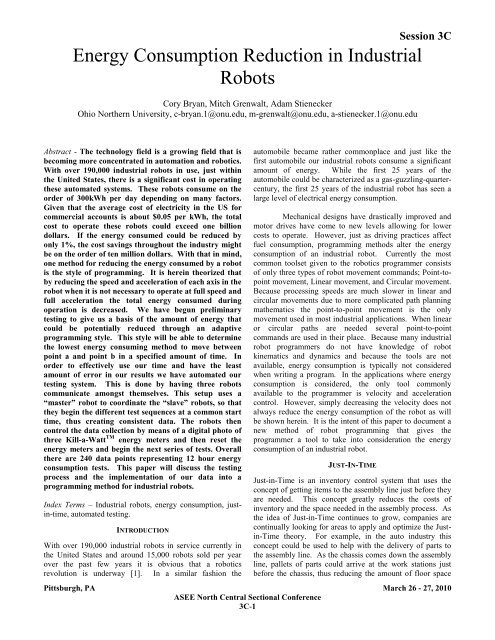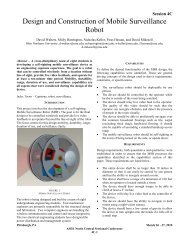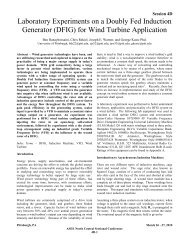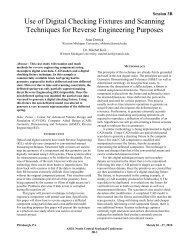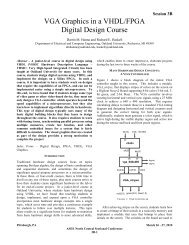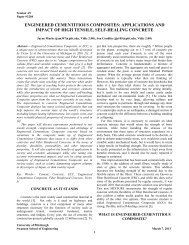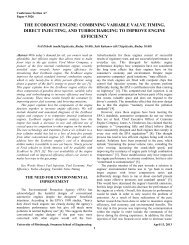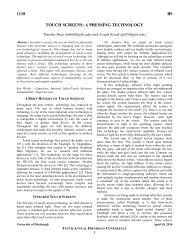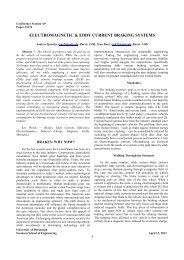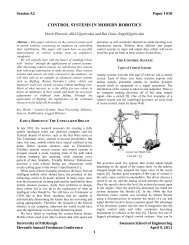energy consumption reduction in industrial robots
energy consumption reduction in industrial robots
energy consumption reduction in industrial robots
You also want an ePaper? Increase the reach of your titles
YUMPU automatically turns print PDFs into web optimized ePapers that Google loves.
Energy Consumption Reduction <strong>in</strong> Industrial<br />
Robots<br />
Cory Bryan, Mitch Grenwalt, Adam Stienecker<br />
Ohio Northern University, c-bryan.1@onu.edu, m-grenwalt@onu.edu, a-stienecker.1@onu.edu<br />
Session 3C<br />
Abstract - The technology field is a grow<strong>in</strong>g field that is<br />
becom<strong>in</strong>g more concentrated <strong>in</strong> automation and robotics.<br />
With over 190,000 <strong>in</strong>dustrial <strong>robots</strong> <strong>in</strong> use, just with<strong>in</strong><br />
the United States, there is a significant cost <strong>in</strong> operat<strong>in</strong>g<br />
these automated systems. These <strong>robots</strong> consume on the<br />
order of 300kWh per day depend<strong>in</strong>g on many factors.<br />
Given that the average cost of electricity <strong>in</strong> the US for<br />
commercial accounts is about $0.05 per kWh, the total<br />
cost to operate these <strong>robots</strong> could exceed one billion<br />
dollars. If the <strong>energy</strong> consumed could be reduced by<br />
only 1%, the cost sav<strong>in</strong>gs throughout the <strong>in</strong>dustry might<br />
be on the order of ten million dollars. With that <strong>in</strong> m<strong>in</strong>d,<br />
one method for reduc<strong>in</strong>g the <strong>energy</strong> consumed by a robot<br />
is the style of programm<strong>in</strong>g. It is here<strong>in</strong> theorized that<br />
by reduc<strong>in</strong>g the speed and acceleration of each axis <strong>in</strong> the<br />
robot when it is not necessary to operate at full speed and<br />
full acceleration the total <strong>energy</strong> consumed dur<strong>in</strong>g<br />
operation is decreased. We have begun prelim<strong>in</strong>ary<br />
test<strong>in</strong>g to give us a basis of the amount of <strong>energy</strong> that<br />
could be potentially reduced through an adaptive<br />
programm<strong>in</strong>g style. This style will be able to determ<strong>in</strong>e<br />
the lowest <strong>energy</strong> consum<strong>in</strong>g method to move between<br />
po<strong>in</strong>t a and po<strong>in</strong>t b <strong>in</strong> a specified amount of time. In<br />
order to effectively use our time and have the least<br />
amount of error <strong>in</strong> our results we have automated our<br />
test<strong>in</strong>g system. This is done by hav<strong>in</strong>g three <strong>robots</strong><br />
communicate amongst themselves. This setup uses a<br />
“master” robot to coord<strong>in</strong>ate the “slave” <strong>robots</strong>, so that<br />
they beg<strong>in</strong> the different test sequences at a common start<br />
time, thus creat<strong>in</strong>g consistent data. The <strong>robots</strong> then<br />
control the data collection by means of a digital photo of<br />
three Kill-a-Watt TM <strong>energy</strong> meters and then reset the<br />
<strong>energy</strong> meters and beg<strong>in</strong> the next series of tests. Overall<br />
there are 240 data po<strong>in</strong>ts represent<strong>in</strong>g 12 hour <strong>energy</strong><br />
<strong>consumption</strong> tests. This paper will discuss the test<strong>in</strong>g<br />
process and the implementation of our data <strong>in</strong>to a<br />
programm<strong>in</strong>g method for <strong>in</strong>dustrial <strong>robots</strong>.<br />
Index Terms – Industrial <strong>robots</strong>, <strong>energy</strong> <strong>consumption</strong>, just<strong>in</strong>-time,<br />
automated test<strong>in</strong>g.<br />
INTRODUCTION<br />
With over 190,000 <strong>in</strong>dustrial <strong>robots</strong> <strong>in</strong> service currently <strong>in</strong><br />
the United States and around 15,000 <strong>robots</strong> sold per year<br />
over the past few years it is obvious that a robotics<br />
revolution is underway [1]. In a similar fashion the<br />
automobile became rather commonplace and just like the<br />
first automobile our <strong>in</strong>dustrial <strong>robots</strong> consume a significant<br />
amount of <strong>energy</strong>. While the first 25 years of the<br />
automobile could be characterized as a gas-guzzl<strong>in</strong>g-quartercentury,<br />
the first 25 years of the <strong>in</strong>dustrial robot has seen a<br />
large level of electrical <strong>energy</strong> <strong>consumption</strong>.<br />
Mechanical designs have drastically improved and<br />
motor drives have come to new levels allow<strong>in</strong>g for lower<br />
costs to operate. However, just as driv<strong>in</strong>g practices affect<br />
fuel <strong>consumption</strong>, programm<strong>in</strong>g methods alter the <strong>energy</strong><br />
<strong>consumption</strong> of an <strong>in</strong>dustrial robot. Currently the most<br />
common toolset given to the robotics programmer consists<br />
of only three types of robot movement commands; Po<strong>in</strong>t-topo<strong>in</strong>t<br />
movement, L<strong>in</strong>ear movement, and Circular movement.<br />
Because process<strong>in</strong>g speeds are much slower <strong>in</strong> l<strong>in</strong>ear and<br />
circular movements due to more complicated path plann<strong>in</strong>g<br />
mathematics the po<strong>in</strong>t-to-po<strong>in</strong>t movement is the only<br />
movement used <strong>in</strong> most <strong>in</strong>dustrial applications. When l<strong>in</strong>ear<br />
or circular paths are needed several po<strong>in</strong>t-to-po<strong>in</strong>t<br />
commands are used <strong>in</strong> their place. Because many <strong>in</strong>dustrial<br />
robot programmers do not have knowledge of robot<br />
k<strong>in</strong>ematics and dynamics and because the tools are not<br />
available, <strong>energy</strong> <strong>consumption</strong> is typically not considered<br />
when writ<strong>in</strong>g a program. In the applications where <strong>energy</strong><br />
<strong>consumption</strong> is considered, the only tool commonly<br />
available to the programmer is velocity and acceleration<br />
control. However, simply decreas<strong>in</strong>g the velocity does not<br />
always reduce the <strong>energy</strong> <strong>consumption</strong> of the robot as will<br />
be shown here<strong>in</strong>. It is the <strong>in</strong>tent of this paper to document a<br />
new method of robot programm<strong>in</strong>g that gives the<br />
programmer a tool to take <strong>in</strong>to consideration the <strong>energy</strong><br />
<strong>consumption</strong> of an <strong>in</strong>dustrial robot.<br />
JUST-IN-TIME<br />
Just-<strong>in</strong>-Time is an <strong>in</strong>ventory control system that uses the<br />
concept of gett<strong>in</strong>g items to the assembly l<strong>in</strong>e just before they<br />
are needed. This concept greatly reduces the costs of<br />
<strong>in</strong>ventory and the space needed <strong>in</strong> the assembly process. As<br />
the idea of Just-<strong>in</strong>-Time cont<strong>in</strong>ues to grow, companies are<br />
cont<strong>in</strong>ually look<strong>in</strong>g for areas to apply and optimize the Just<strong>in</strong>-Time<br />
theory. For example, <strong>in</strong> the auto <strong>in</strong>dustry this<br />
concept could be used to help with the delivery of parts to<br />
the assembly l<strong>in</strong>e. As the chassis comes down the assembly<br />
l<strong>in</strong>e, pallets of parts could arrive at the work stations just<br />
before the chassis, thus reduc<strong>in</strong>g the amount of floor space<br />
Pittsburgh, PA March 26 - 27, 2010<br />
ASEE North Central Sectional Conference<br />
3C-1
wasted for part storage and part rout<strong>in</strong>g. The manufactur<strong>in</strong>g<br />
<strong>in</strong>dustry has used this Lean manufactur<strong>in</strong>g pr<strong>in</strong>ciple to<br />
elim<strong>in</strong>ate waste <strong>in</strong> many aspects but it has yet to be applied<br />
to mach<strong>in</strong>ery and automated equipment.<br />
As described above, the movement style most<br />
common <strong>in</strong> robotics is the Po<strong>in</strong>t-to-Po<strong>in</strong>t move. The Po<strong>in</strong>tto-Po<strong>in</strong>t<br />
move moves the end-of-arm-tool<strong>in</strong>g from one po<strong>in</strong>t<br />
<strong>in</strong> the work envelope to the next programmed po<strong>in</strong>t without<br />
consideration to the path taken. The robot programm<strong>in</strong>g<br />
takes the robot through the program as quickly as possible;<br />
often this is not the most <strong>energy</strong> efficient programm<strong>in</strong>g<br />
style. An <strong>energy</strong> efficient robot would make use of the Just<strong>in</strong>-Time<br />
concept to complete tasks just <strong>in</strong> time with reduced<br />
<strong>energy</strong> use. This <strong>energy</strong> sav<strong>in</strong>gs does not come from<br />
alter<strong>in</strong>g the cycle time of the process, but rather through the<br />
use of an adaptive program that calculates the most efficient<br />
path and lowest <strong>energy</strong> levels possible.<br />
If it is assumed that before a movement is to be<br />
made the velocity and acceleration are zero and that after a<br />
movement is completed the velocity and acceleration are<br />
also zero, the lowest levels of velocity and acceleration can<br />
be computed given a maximum time allotted for the<br />
movement. In the simplest form an axis movement can be<br />
def<strong>in</strong>ed as a simple trapezoidal motion profile. This<br />
assumes a constant acceleration and maximum velocity.<br />
Algebra yields equation 1 for a trapezoidal motion profile<br />
Session 3C<br />
a <br />
vt<br />
f<br />
2<br />
v<br />
and v <br />
<br />
1<br />
2<br />
at<br />
f<br />
<br />
1<br />
4<br />
2<br />
a t<br />
2<br />
f<br />
a<br />
(1)<br />
where t f is the total time required for the move, is the<br />
change <strong>in</strong> angle of the axis, a is the acceleration and v is the<br />
velocity. These equations can be applied to each axis to give<br />
the m<strong>in</strong>imum allowed velocity and acceleration to complete<br />
a s<strong>in</strong>gle axis motion with<strong>in</strong> a given time. Therefore, once<br />
the maximum time is known an algorithm can beg<strong>in</strong> with the<br />
most <strong>energy</strong> efficient comb<strong>in</strong>ation of acceleration and<br />
velocity and move up the <strong>energy</strong> <strong>consumption</strong> meter until it<br />
calculates the move to be completed on time. However, the<br />
<strong>energy</strong> <strong>consumption</strong> of each axis at all levels of acceleration<br />
and velocity must be known.<br />
TESTING<br />
Our test<strong>in</strong>g process is still <strong>in</strong> the prelim<strong>in</strong>ary stages, but it<br />
appears promis<strong>in</strong>g for our theory of <strong>energy</strong> <strong>reduction</strong>.<br />
Test<strong>in</strong>g is done with the KUKA KR3 <strong>in</strong>dustrial robot with<br />
an <strong>in</strong>stalled motor capacity of 880W, us<strong>in</strong>g three <strong>robots</strong> to<br />
help test <strong>in</strong>dividual axes. Each axis is moved through a<br />
n<strong>in</strong>ety-degree sweep at a def<strong>in</strong>ed acceleration and velocity<br />
over the course of twelve hours [2]. As the twelve-hour<br />
<strong>in</strong>tervals progress the acceleration and velocities are varied<br />
so the data collection was possible. As the time frames for<br />
test<strong>in</strong>g are lengthy the test<strong>in</strong>g process has been completely<br />
automated.<br />
FIGURE 1<br />
AUTOMATED TESTING SYSTEM<br />
A “master” robot is used to control the “slave”<br />
<strong>robots</strong> and beg<strong>in</strong> the test series at a common time. The<br />
<strong>robots</strong> are all <strong>in</strong>dividually programmed with the various<br />
acceleration and velocity variables, as each test <strong>in</strong>terval is<br />
concluded the master robot activates a circuit that takes a<br />
digital photo of three Kill-a-Watt TM <strong>energy</strong> meters and stores<br />
the photo <strong>in</strong> a file that allows for manual entry <strong>in</strong>to a spread<br />
sheet at a later time. After the picture is stored the circuit<br />
will reset the power to the <strong>energy</strong> meters and the test<strong>in</strong>g<br />
process beg<strong>in</strong>s with the next acceleration and velocity<br />
comb<strong>in</strong>ation. Currently, the test<strong>in</strong>g has been focused on four<br />
values of acceleration represent<strong>in</strong>g 25%, 50%, 75%, and<br />
100% of the robot’s capability and ten values of velocity<br />
represent<strong>in</strong>g 10% through 100% <strong>in</strong> 10% <strong>in</strong>crements. These<br />
comb<strong>in</strong>ations yield 40 tests per axis. With six axes per robot<br />
this yields 240 twelve-hour tests. Currently, most of the 240<br />
tests are complete and work has begun develop<strong>in</strong>g an<br />
algorithm that implements the procedure def<strong>in</strong>ed above.<br />
This algorithm will allow the robot programmer to enter a<br />
movement command along with a maximum time allowed<br />
and potentially write a program that saves his or her<br />
employer significant <strong>energy</strong> costs.<br />
Pittsburgh, PA March 26 - 27, 2010<br />
ASEE North Central Sectional Conference<br />
3C-2
CURRENT RESULTS<br />
Each twelve-hour test on each axis was recorded and the set<br />
is shown below. At the time of writ<strong>in</strong>g there were eleven<br />
total tests rema<strong>in</strong><strong>in</strong>g of the 40 required for each axis <strong>in</strong> axes<br />
1-3. These data po<strong>in</strong>ts have been estimated <strong>in</strong> the follow<strong>in</strong>g<br />
charts charts. Test results for axes 4,5, and 6 have been<br />
omitted because many po<strong>in</strong>ts would have to be estimated.<br />
Session 3C<br />
operate (at $0.05 per kWh) operat<strong>in</strong>g without a payload. If<br />
this was reduced by 2.3% by reduc<strong>in</strong>g 25% of the moves<br />
from 100% velocity to 70% velocity the sav<strong>in</strong>gs would be<br />
on the order of $4.60 per year per robot. This is<br />
<strong>in</strong>significant and not worth the effort, but because the<br />
average robot <strong>in</strong> <strong>in</strong>dustry is most certa<strong>in</strong>ly larger than the<br />
KUKA KR3 with its 3kg payload, the sav<strong>in</strong>gs may be much<br />
greater. It is estimated that because the <strong>in</strong>stalled motor<br />
capacity on a KUKA KR150 robot is 21.6kW (24.5 times<br />
that of the KR3) its sav<strong>in</strong>gs would also be much larger (on<br />
the order of $110 per year). Additionally if a payload is<br />
be<strong>in</strong>g transferred the sav<strong>in</strong>gs can be even higher. Due to<br />
such a large number of <strong>robots</strong> <strong>in</strong> operation <strong>in</strong> the United<br />
States alone, if this were applied to 10% of the <strong>robots</strong><br />
currently <strong>in</strong> operation the sav<strong>in</strong>gs across the country would<br />
be on the order of $2M per year. A look at the worldwide<br />
sav<strong>in</strong>gs yields a sav<strong>in</strong>gs on the order of $11M per year.<br />
FIGURE 2<br />
KUKA KR3 AXIS 1 ENERGY CONSUMPTION – 90 DEGREE MOVEMENT, 9<br />
SECOND CYCLE<br />
FIGURE 4<br />
KUKA KR3 AXIS 3 ENERGY CONSUMPTION – 90 DEGREE MOVEMENT, 9<br />
SECOND CYCLE<br />
FIGURE 3<br />
KUKA KR3 AXIS 2 ENERGY CONSUMPTION – 90 DEGREE MOVEMENT, 9<br />
SECOND CYCLE<br />
These results <strong>in</strong>dicate a large potential cost sav<strong>in</strong>gs<br />
for larger <strong>robots</strong>. The KUKA KR3 is a very small robot<br />
with a payload of only 3kg and has an <strong>in</strong>stalled motor<br />
ADAPTIVE ENERGY REDUCTION<br />
The methods for reduc<strong>in</strong>g <strong>energy</strong> above are great for<br />
reduc<strong>in</strong>g <strong>energy</strong> while ma<strong>in</strong>ta<strong>in</strong><strong>in</strong>g a traditional po<strong>in</strong>t-topo<strong>in</strong>t<br />
movement with a consistent path. Many times there<br />
are constra<strong>in</strong>ts on movements and paths due to obstructions<br />
so the path taken must rema<strong>in</strong> the same after the<br />
programmer has deemed it okay dur<strong>in</strong>g test<strong>in</strong>g. In the<br />
program test<strong>in</strong>g phase the programmer takes the robot<br />
through its programmed motions to <strong>in</strong>sure the paths<br />
calculated by the robot are possible to carry out based on<br />
nearby equipment. This same procedure would be carried<br />
out when the <strong>energy</strong> efficient movement is programmed<br />
only because each axis may be mov<strong>in</strong>g different speeds the<br />
robot’s path may be someth<strong>in</strong>g unexpected so care would<br />
need to be exercised when us<strong>in</strong>g this new command.<br />
capacity of only 880W. If all axes are operat<strong>in</strong>g the<br />
An additional method to reduce the <strong>energy</strong><br />
expected <strong>energy</strong> <strong>consumption</strong> for this robot is on the order consumed <strong>in</strong> the robot is very similar to the method<br />
of 11kWh per day cost<strong>in</strong>g approximately $200 per year to mentioned thus far except that it allows the robot to record<br />
Pittsburgh, PA March 26 - 27, 2010<br />
ASEE North Central Sectional Conference<br />
3C-3
its own <strong>energy</strong> <strong>consumption</strong> data on each axis and “learn”<br />
the most <strong>energy</strong> efficient way to go from po<strong>in</strong>t a to po<strong>in</strong>t b<br />
with a given payload. This method, however, requires great<br />
care <strong>in</strong> implementation as the programmer is allow<strong>in</strong>g the<br />
computer to take new paths <strong>in</strong> which may conta<strong>in</strong> an<br />
obstruction. While this would take greater care <strong>in</strong> the<br />
programm<strong>in</strong>g stage it would produce optimal results. This<br />
style of programm<strong>in</strong>g has not yet been tested because the<br />
results of test<strong>in</strong>g currently underway would be needed to<br />
build this algorithm accurately. However, the general<br />
concept is to record the <strong>energy</strong> consumed <strong>in</strong> each axis for<br />
one particular movement by record<strong>in</strong>g the current dur<strong>in</strong>g the<br />
move at a suitable sampl<strong>in</strong>g frequency [3]. After the move<br />
is complete an iteration would occur to reduce the recorded<br />
current <strong>in</strong> the axis with the highest <strong>energy</strong> consumed by<br />
mak<strong>in</strong>g a change <strong>in</strong> the other axes. An iterative path<br />
plann<strong>in</strong>g algorithm can be constructed to reduce the <strong>energy</strong><br />
consumed at the cost of longer programm<strong>in</strong>g and start-up<br />
times.<br />
At the extreme end of the spectrum the dynamics of a robot<br />
manipulator could be taken <strong>in</strong>to consideration with a given<br />
payload at a certa<strong>in</strong> distance from the tool center po<strong>in</strong>t.<br />
However, unless this complicated analysis is completed for<br />
every move every time a new payload is considered the<br />
method isn’t useful. Because of this very high level of<br />
analysis it is doubtful that the robot programmer would use<br />
this method. However, the adaptive method of <strong>energy</strong><br />
<strong>reduction</strong> would likely have the same outcome or at least<br />
come very close to it.<br />
CONCLUSION AND FUTURE STEPS<br />
These results are prelim<strong>in</strong>ary, but the above estimates are<br />
certa<strong>in</strong>ly a reason to cont<strong>in</strong>ue <strong>in</strong>to further test<strong>in</strong>g. It is our<br />
<strong>in</strong>tent to complete the test<strong>in</strong>g currently underway and use the<br />
Session 3C<br />
results to implement an algorithm <strong>in</strong>to the KUKA KR3 that<br />
allows the programmer the luxury of tak<strong>in</strong>g <strong>energy</strong><br />
<strong>consumption</strong> <strong>in</strong>to consideration. Additionally, further<br />
communication with the manufacturer of the robot and more<br />
analysis on motion profiles will allow us to closer<br />
approximate the total time required to move from po<strong>in</strong>t A to<br />
po<strong>in</strong>t B and better optimize the <strong>energy</strong> consumed. Further<br />
test<strong>in</strong>g will then be completed to determ<strong>in</strong>e the results of the<br />
algorithm when all six axes are function<strong>in</strong>g <strong>in</strong> conjunction<br />
and the above estimates will be corrected with actual results.<br />
These results will be <strong>in</strong>cluded <strong>in</strong> the revised paper before the<br />
conference. At that po<strong>in</strong>t the research will then cont<strong>in</strong>ue<br />
<strong>in</strong>to a much larger and realistic robot along with more<br />
accurate <strong>energy</strong> meter<strong>in</strong>g.<br />
REFERENCES<br />
1. Robotics Industries Association, www.robotics.org, 12/4/2009.<br />
2. KUKA Software Expert Programm<strong>in</strong>g V0, 9/26/2003.<br />
3. KUKA Software System Variables V2, 3/30/2004.<br />
AUTHOR INFORMATION<br />
Cory Bryan Manufactur<strong>in</strong>g Technology Student, Ohio<br />
Northern University, Department of Technological Studies,<br />
Ada, OH, 45810, c-bryan@onu.edu.<br />
Mitch Grenwalt Manufactur<strong>in</strong>g Technology Student, Ohio<br />
Northern University, Department of Technological Studies,<br />
Ada, OH, 45810, m-grenwalt@onu.edu.<br />
Adam W. Stienecker Assistant Professor and Director of<br />
Ohio Northern University’s Robotics Center of Excellence,<br />
Ohio Northern University, Department of Technological<br />
Studies, Ada, OH, 45810, a-stienecker.1@onu.edu.<br />
Pittsburgh, PA March 26 - 27, 2010<br />
ASEE North Central Sectional Conference<br />
3C-4


